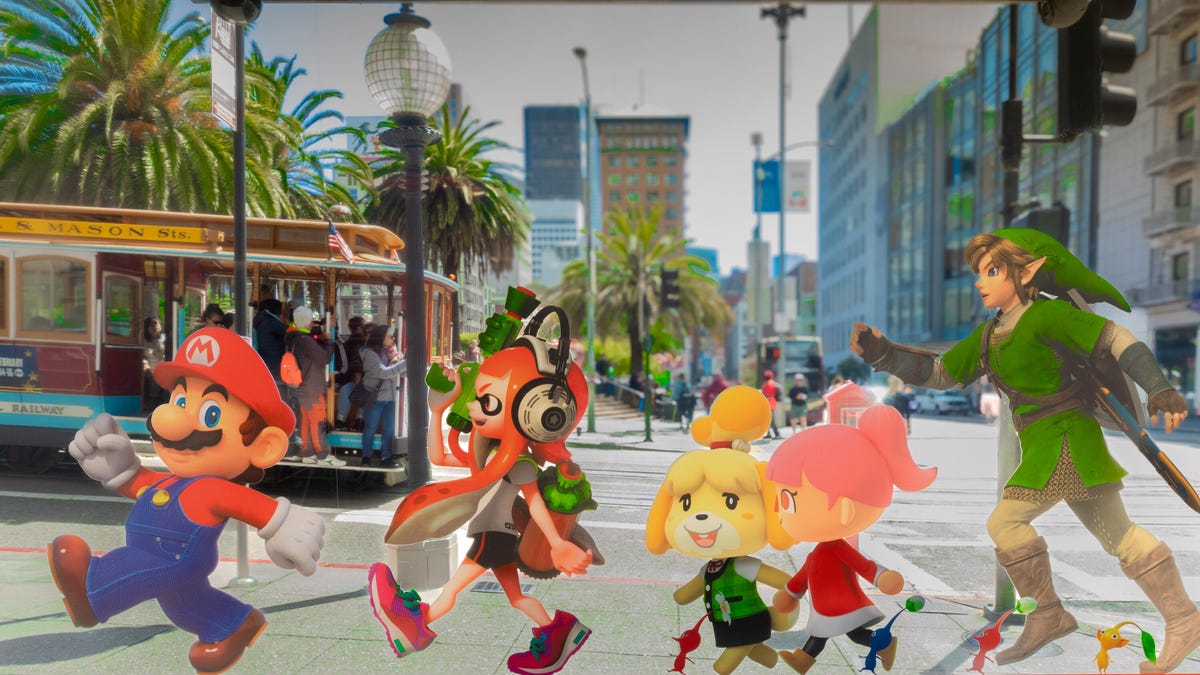Technologies
I Left My Heart Container in Nintendo’s San Francisco Store
Nintendo’s First West Coast Store is a Warp Pipe to Whimsy and Delightful Gamer Decor.

I’m in a group of adults slowly descending a staircase in a brightly lit white store, small gasps of joy escaping our mouths as walls of smiling squid toys come into view. Our tour guide is wrapping up his tour, and as he rattles off his last fact, he eyes the crowd. «Think you guys are ready to shop?» My reply echoes the words of former Nintendo Chief Operating Officer Reggie Fils-Aimé when he tested the Wii Board at E3 2007: My body is ready.
Japanese gaming giant Nintendo opened its first-ever West Coast store in San Francisco on Thursday — the second in the US after its New York City storefront. While it stocks lots of company merch featuring the company’s most iconic characters like Mario, Peach, Link, Zelda and way too many Pokemon, its website alludes to future events like those held at its other stores.
A few days earlier, CNET was treated to a first-hand look at all the new goodies and gadgets awaiting fans in San Francisco.
Inside the store
Set at the intersection of Geary and Powell in San Francisco’s Union Square neighborhood, the first thing you notice is the parade of Nintendo characters lining the store’s windows, with Mario leading the congregation to the main doors. Upon entering the store, you’re greeted by the clean, white aesthetic that the Nintendo brand is known for.
«We want [Nintendo San Francisco] to be much more than just a store,» said Nintendo Senior Regional General Manager PJ Sadler, a manager of the NYC Nintendo store who led the tour of the new location. «We want it to be an immersive experience, we want to immerse you in our characters, with our world.»
In that spirit, a Nintendo store associate told me several Pikmin figurines were hidden throughout the store for guests to find. (I counted five; they told me there were still a few more.)
There are the requisite store exclusives, the items you can find only at the San Francisco location that set it apart from its NYC counterpart — namely, the SF-branded water bottles, T-shirts, and hoodies that say «Nintendo San Francisco.» I found those designs a little lackluster and rather sterile; I was hoping to see a little more San Francisco flair. New York City once had a collection in kanji, for example. But at least you can also find the Nintendo character parade motif adorning other San Francisco souvenirs, including exclusive minifigures and bags. Sadler noted that any products with a red Nintendo square logo indicate they can be bought only in the Nintendo US locations, either in San Francisco or New York (there were no unique marks for SF exclusives).
Also on the ground floor was a section dedicated to actual gaming equipment, including an area where customers can put together their own Nintendo Switch OLED with their choice of colored Joy-Cons and docks. (Nintendo representatives were very coy about what, if anything, would be happening at the store for the upcoming launch of the Nintendo Switch 2 on June 5.) Among the other controllers and accessories was a shelf of Nintendo Alarmo clocks, the company’s big surprise hardware launch of 2024, waiting to be taken home.
Downstairs is where they had the «big guns,» so to speak, or at least the Master Swords. Similar to Nintendo’s New York store, there are dedicated areas for Splatoon and Legend of Zelda, as well as Pikmin, Kirby, and Pokemon. There was also a giant projector screen for watching shoppers play games, alongside a giant wall of Amiibo with harder-to-find figures such as Sora from Super Smash Bros and Kingdom Hearts.
A sales associate kindly walked me through a kiosk where visitors can check in daily for Nintendo Platinum Points, which can be used for My Nintendo Rewards in the Nintendo eShop. «I just moved into a new place, so I’ve been stocking up on Animal Crossing coasters,» the associate confided.
Cozy merch forever
Though it’s been a while since I’ve been to the New York store, reconnaissance from friends and TikTok confirmed that a big theme for NY is Pokemon, featuring an almost life-size Pokemon Center where herds of Pikachu frolic on the shelves.
While Pokemon has a presence in the San Francisco counterpart (I almost walked away with a Psyduck backpack), there seems to be a greater dedication to more twee, cozy series such as Animal Crossing and Pikmin, as well as adorably subtle game decor in general.
The Animal Crossing corner featured a slew of home goods, such as an adorable cottage-core coffee grinder branded with «The Roost,» the in-game cafe headed by character Brewster the Pigeon, with a matching cup and saucer set. Other kitchen goods like an apron, glass jar set and oven mitt elicited a few squeals from me and another sales associate, who kindly pointed out the equally kawaii Animal Crossing stationery with stickers, sticky notes, notepads and character-themed pens.
Downstairs in the Legend of Zelda section, I was taken with the Zelda Fairy collection, particularly a large faux leather tote purse and fairy-themed wallets with iridescent flourishes. Lovely golden Heart Container-shaped accessories, of which not nearly enough found their way into my shopping bag, framed the scene.
Down the line, rows of enamel Kirby keychains and plush Waddle-Dees eyed me hopefully from their perches while a tower of Pikmin blind boxes and flower bud vases (successfully) tempted me from over my shoulder.
Price-wise, I was pleasantly surprised that most items weren’t egregiously expensive and more similar to pricing you’d find at a theme park. I’d expected the aforementioned coffee grinder to be somewhere around $70, but it was priced at $40. Similarly, many of the more intricately designed wallets and bags were at the $35 price or under. Pikmin blind boxes were $10. But there were still outliers — a sleek Team Rocket anorak was marked at $120, for example.
Why San Francisco? Why now?
Before 2025, Nintendo had four official stores around the world: three in Japan (Kyoto, Tokyo and Osaka) and one in the US (New York). Now, San Francisco marks its fifth retail location selling merch directly to fans.
The San Francisco store’s opening comes at a pivotal time for the city’s downtown economy. Retail vacancies in San Francisco have hit record highs since the outbreak of the COVID-19 pandemic, with a number of flagship stores shutting down, including the Westfield San Francisco Centre and Macy’s, the former epicenter of the city’s Union Square shopping area.
When Nintendo announced the official opening plans for the store in May 2024, then-Mayor London Breed posted on X, «We’re excited for San Francisco’s future and look forward to welcoming this iconic brand to our City.»
Supervisor Danny Sauter, who represents San Francisco’s District 3, which includes Union Square, told KQED in March, «The narrative on San Francisco is starting to shift…[p]eople are willing to take a chance on San Francisco again, and it’s remarkable how that was not the case six months ago.»
Whatever the city’s reputation, fan response has been immense, with «Warp Pipe Pass» shopping visit reservations for opening week sold out in minutes, continuing on into the Memorial Day weekend. Locals have been peeking into the windows and taking pictures as soon as the signage went up. Reddit user CaterpillarFederal43 posted a picture in the San Francisco subreddit in April 2025 with his dogs in costume, noting he visits every day for a chance to use StreetPass (a peer-to-peer feature on the Nintendo 3DS) with fellow fans.
End credits
San Francisco has a legacy of gaming culture, from the former Walk of Game to the annual Game Developers Conference held in Moscone Center. Now it has a retail location and event space for one of the biggest gaming companies in the world to welcome fans.
Whether you’re a Nintendo superfan with an Isabelle-patterned sweater vest or a tourist looking for a «gamer-y» souvenir for a relative, the San Francisco Nintendo store looks like a perfect place to spend all your rupees and bells. Just watch out for mischievous Pikmin along the way.
Nintendo Store Levels Up in San Francisco: A First Look Inside the Ultimate Fan Experience
Technologies
Live-Action ‘Call of Duty’ Movie Reportedly Being Co-Written by Taylor Sheridan
The Yellowstone co-creator will reportedly team up with Peter Berg on the Paramount film.

Yellowstone, Landman and, now, Call of Duty. Taylor Sheridan, co-creator of the aforementioned hit shows, will co-write Paramount and Activision’s upcoming live-action video game adaptation, according to a report from Variety on Thursday.
Peter Berg will also co-write and direct the movie, which was announced last month. Berg previously directed films including 2018’s Mile 22, 2012’s Battleship and 2013’s Lone Survivor, while Sheridan’s movie credits include 2016’s Hell or High Water and 2017’s Wind River. Berg, Sheridan and David Glasser will produce the Call of Duty film.
Don’t miss any of our unbiased tech content and lab-based reviews. Add CNET as a preferred Google source.
Call of Duty is a first-person shooter military video game series that debuted in 2003. CNET senior writer David Lumb calls it «arguably the biggest shooter franchise in gaming, with millions of players picking up every year’s new entry to the series.»
Lumb said the franchise is known for its bombastic single-player campaigns, which feature globe-spanning plots that rival those of the Mission Impossible films. «A Call of Duty movie has a lot of material to draw from,» Lumb said.
He also noted that Berg’s direction of Lone Survivor would fit the grim military heroism of Call of Duty, while Taylor Sheridan’s spate of neo-Western films and shows could lend a frontier adventurism to the film.
«Their collective works seemingly harmonize with the jingoistic pro-military tune of Activision’s shooter franchise — which is probably a good thing for Call of Duty fans,» Lumb concluded.
A release announcing Paramount and Activision’s film deal teased that it’ll be «designed to thrill its massive global fan base by delivering on the hallmarks of what fans love about the iconic series, while boldly expanding the franchise to entirely new audiences.» It didn’t include cast or plot information.
The update follows recent news that Sheridan is leaving Paramount for NBCUniversal. Paramount did not immediately respond to a request for comment.
Technologies
US Government Urges Total Ban of Our Most Popular Wi-Fi Router
Technologies
Animal Crossing Update Adds Lego Furniture, With a Switch 2 Version Arriving the Same Day
Fans of Animal Crossing will have a reason to go back to their island.

Animal Crossing fans just received a big surprise, and it’s not just a new content update. A Switch 2 version is on its way.
Animal Crossing: New Horizons will receive its first big update in three years, according to a post from Nintendo on Thursday. The update, labeled 3.0, will roll out on Jan. 15, the same day the Switch 2 version of the game will be available for purchase.
Released for the original Switch back in 2020, New Horizons was the first Animal Crossing game to come to a Nintendo console since 2008’s Animal Crossing: City Folk for the Nintendo Wii.
Nintendo regularly updated New Horizons for two years after its release, but stopped at update 2.0.6 released in November 2022. Two updates were added earlier in the year to prepare the game for playability on the Switch 2.
Animal Crossing 3.0 Update
In the 3.0 update coming on Jan. 15, a new hotel is opening. Players can help bring in guests to stay at the hotel by decorating guest rooms and dressing up mannequins to sell resort clothing.
For those who haven’t touched New Horizons in years, a Reset Service will be available. Players can have their island cleaned up, and items can be stored away or trashed for those who want a clean slate.
Players with a Nintendo Switch Online membership will have access to up to three islands, where they can explore and do as they please. These new areas are available on Slumber Island. It’s up to the player to decide how the island will look, what items or plants are on it and even which characters will be found on the island. Players can also invite friends to build it together.
New Horizons will feature special collaborations and Nintendo retro gear. Lego items will be available in the update for players to decorate their homes with or clothing to dress up their villagers with. Retro Nintendo consoles, such as the NES and Game Boy, can also be used as decorative items.
If the player has a Switch Online subscription, some classic titles such as Ice Climbers and Dr. Mario can be played via these in-game devices. There are also special items based on The Legend of Zelda and Splatoon series when players tap their amiibo from those games onto the Switch while playing.
Animal Crossing: New Horizons on Switch 2
Switch 2 owners can get in on the digital life game with Animal Crossing: New Horizons — Nintendo Switch 2 Edition. Not only will this new version come with updated graphics, including 4K resolution in TV mode, but it will also add special features that can only be done on the newest console.
One of the features is mouse controls for the Joy-Con 2. Players will be able to use the controller as a mouse to decorate indoors, create custom designs and write handwritten messages for the bulletin board.
Residents in the game can now be found by saying their name into the Switch 2’s built-in microphone while using the megaphone in the game. Multiplayer has also improved dramatically, with 12-player sessions available for those playing on the new edition, and CameraPlay is supported to allow players to see one another.
Animal Crossing: New Horizons for the Nintendo Switch 2 will be available for purchase on Jan. 15 for $65. Owners of the original Switch version of New Horizons can upgrade to the Switch 2 version for $5.
-

 Technologies3 года ago
Technologies3 года agoTech Companies Need to Be Held Accountable for Security, Experts Say
-

 Technologies3 года ago
Technologies3 года agoBest Handheld Game Console in 2023
-

 Technologies3 года ago
Technologies3 года agoTighten Up Your VR Game With the Best Head Straps for Quest 2
-

 Technologies4 года ago
Technologies4 года agoVerum, Wickr and Threema: next generation secured messengers
-

 Technologies4 года ago
Technologies4 года agoBlack Friday 2021: The best deals on TVs, headphones, kitchenware, and more
-

 Technologies4 года ago
Technologies4 года agoGoogle to require vaccinations as Silicon Valley rethinks return-to-office policies
-

 Technologies4 года ago
Technologies4 года agoOlivia Harlan Dekker for Verum Messenger
-

 Technologies4 года ago
Technologies4 года agoiPhone 13 event: How to watch Apple’s big announcement tomorrow
